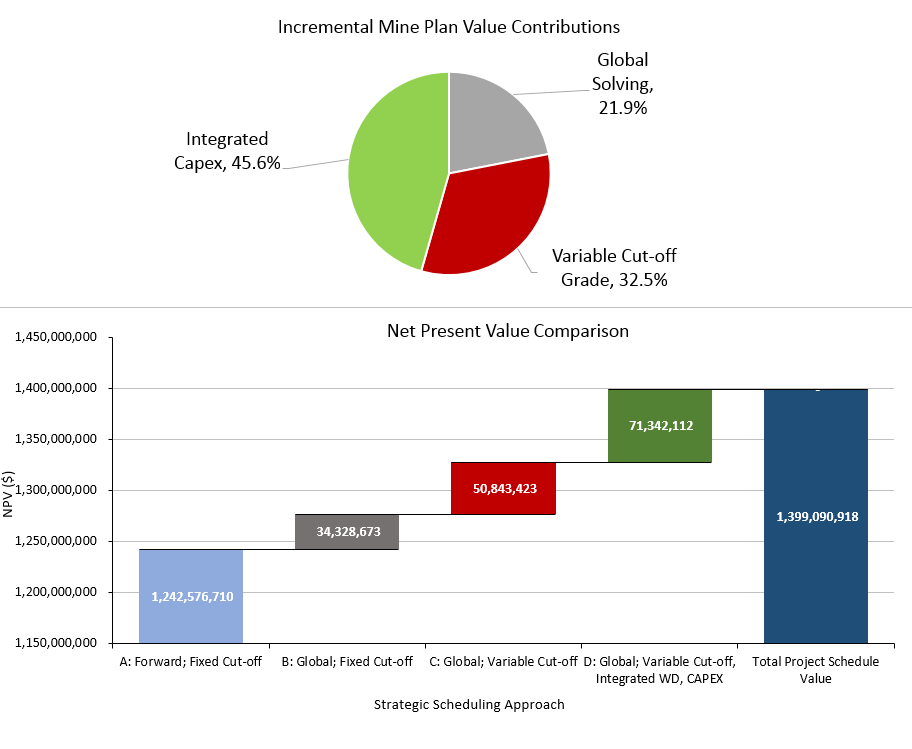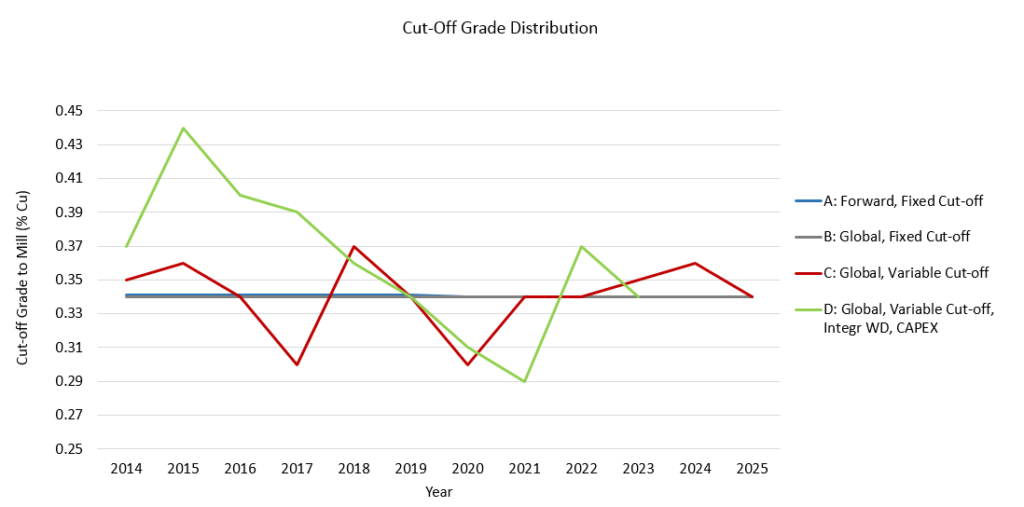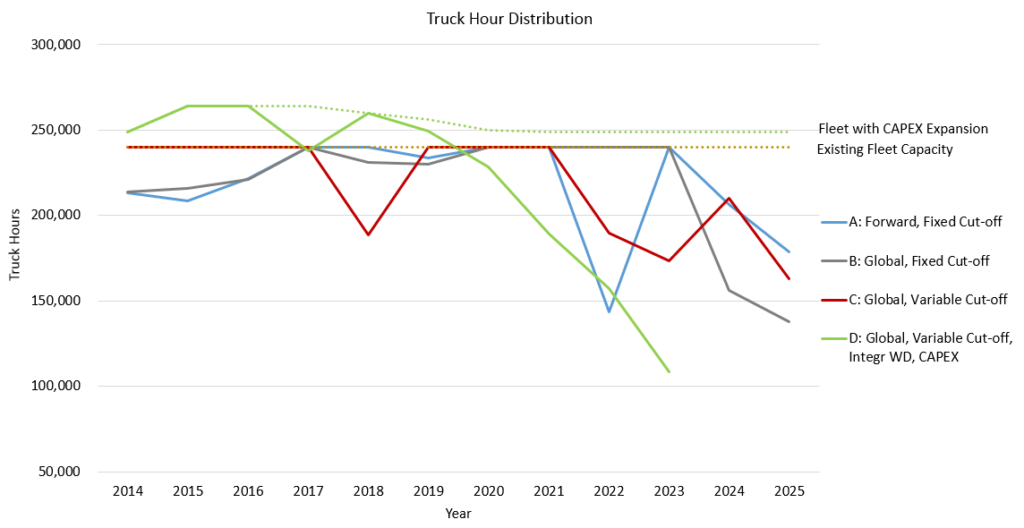Every good mine planner knows that the strategic mine schedule is fundamental to the success of the mining business. It provides a whole host of critical information which guides and informs decisions that impact the value of the mining operation. What is not always evident, however, is that a great deal of this value is made (or lost) through the way the problem is handled.

The practice of strategic mine scheduling addresses all of the items below, while maximizing value for the business:
- The Material Extraction Schedule: “If and when a block is mined,” accounting for any possible downstream destination options available, whilst accounting for the relative contributions of other blocks in the same period.
- Cut-off/Cut-over Policies: “Is it ore or waste?” given all temporal and financial inputs including mining and processing costs, haulage costs, recoveries, etc.
- Processing Destinations: “Where do I send it?” accounting for plant constraints, capacities, recoveries, and alternative destinations with the ability to stockpile/reclaim material as an additional option.
- Mining Capacity: “What equipment will I need?” calculating for variable origins and destinations, associated paths, and modelled costs.
- Waste Dump Sequencing: “Where does the waste go?” accounting for destination selection and practical development precedences.
- Decisions for Capital Investment: “Should I spend $X to gain Y units of capacity? How often? When?” taking into account the effects on the mine schedule and the total project value.
The Traditional Approach
There is clearly a lot of work involved in handling this complex problem. So much, in fact, that some routinely take measures to reduce the problem to a workable state or to make it fit the tools available .
Some common characteristics of this problematic, traditional approach are the following:
- Policy decisions are made early and generally with respect to material destinations.
- Key decisions, such as equipment requirements and the financial impact of capital expenditures, are made through post-scheduling manual calculations.
- The schedule is solved one period at a time in a forward fashion.
- Waste routing is highly generalized or addressed after the mining sequence is set.
While imposing these simplifications allows us to produce a solution, it typically involves numerous iterations, can result in a disjunctive schedule that causes downstream disruptions, and almost always leaves value on the table.
The Integrated Approach
A different way to approach this problem is to leverage optimization technology to find the optimal solution. This approach integrates all steps and makes all decisions within one iteration.
The focus of this method is to model as many feasible alternatives as possible, and let the power of optimization solve for our value objective.
In planning terms, the integrated approach incorporates the following aspects:
- The destinations for each block are determined during the optimization, therefore the cut-off grade is an output resulting from the modelled conditions over time.
- Key decisions such as equipment requirements and the financial impact of capital expenditures are modelled within the problem so they are directly tied to the resulting mining sequence and total project valuation.
- The schedule is solved globally, considering the effects of decisions on all periods simultaneously.
- Waste routing is optimized with the mining sequence, with full understanding of volumetric capacity constraints, transport considerations, and development precedences.
For Comparison’s Sake: A Conceptual Example
So let’s consider a simple mining example to demonstrate where the unlocked value is.
The Scenario
In this scenario, we have an open pit copper mine designed into multiple phases. There is a single process plant with a fixed capacity and a single waste dump location with multiple lifts.
Our existing truck-shovel fleet provides the installed mining capacity, which is currently limited by haulage. Our task is to develop a LOM schedule while also considering whether we should spend capital to increase the size of our trucking fleet.
The Methodology
We will generate mining schedules for our project using four different methods of increasing complexity. These methods represent the stepwise evolution from traditional (A) to integrated (D) approaches:
- A: Forward Scheduling with Fixed Cut-off Grade
- B: Global Scheduling with Fixed Cut-off Grade
- C: Global Scheduling with Variable Cut-off Grade
- D: Global Scheduling with Variable Cut-off Grade, Integrated Waste Dumping, and Capital Expenditure
The Results
The results of this study show some obvious impacts of the integrated approach on the schedule:
Cut-off Grade Distributions
- The integrated approach (method D) shows a significant increase in the cut-off grade distribution in the first years. This allows us to process high-revenue material earlier in the schedule with less discounting.
- The interaction of multiple constraints such as haulage capacity, truck hours costs, and in-pit vertical advance further restrict and complicate the decision about the optimal destination and therefore the effective cut-off grade.
Haulage (Truck Hour) Distributions
- Trucking is constrained to the existing fleet capacity in the mid-mine life for methods A, B and C as they do not model capital expansion.
- The integrated approach (method D) determines the optimal timing to purchase additional trucks. This increased haulage capacity has a ramp-up rate and a fixed lifecycle profile which represent the equipment’s real operating life.
Net Present Value Comparison
However, what is most astounding in this example is the magnitude of the differences between the values for each of the schedules produced for this open pit mine by the four different methods.
The Global scheduling with Fixed Cut-off Grade increases the NPV by 2.76%. Global scheduling with variable Cut-off Grade increases the NPV by 6.85%. The Integrated approach with optional Capital Expenditure gives a whopping 12.60% increase in the NPV of the mine. The relative contributions of each of the components leading up to the integrated solution (D) can be seen in the charts below.
 As mine planners, we know that real situations are often much more complicated. However, even with this simple example, you can see the increasing value contribution made through a more sophisticated and integrated approach can unlock enormous potential.
As mine planners, we know that real situations are often much more complicated. However, even with this simple example, you can see the increasing value contribution made through a more sophisticated and integrated approach can unlock enormous potential.
Want more value? Learn how to use a more integrated approach. Contact us to access the project file so you can have a closer look at this integrated schedule example in our free viewer.

